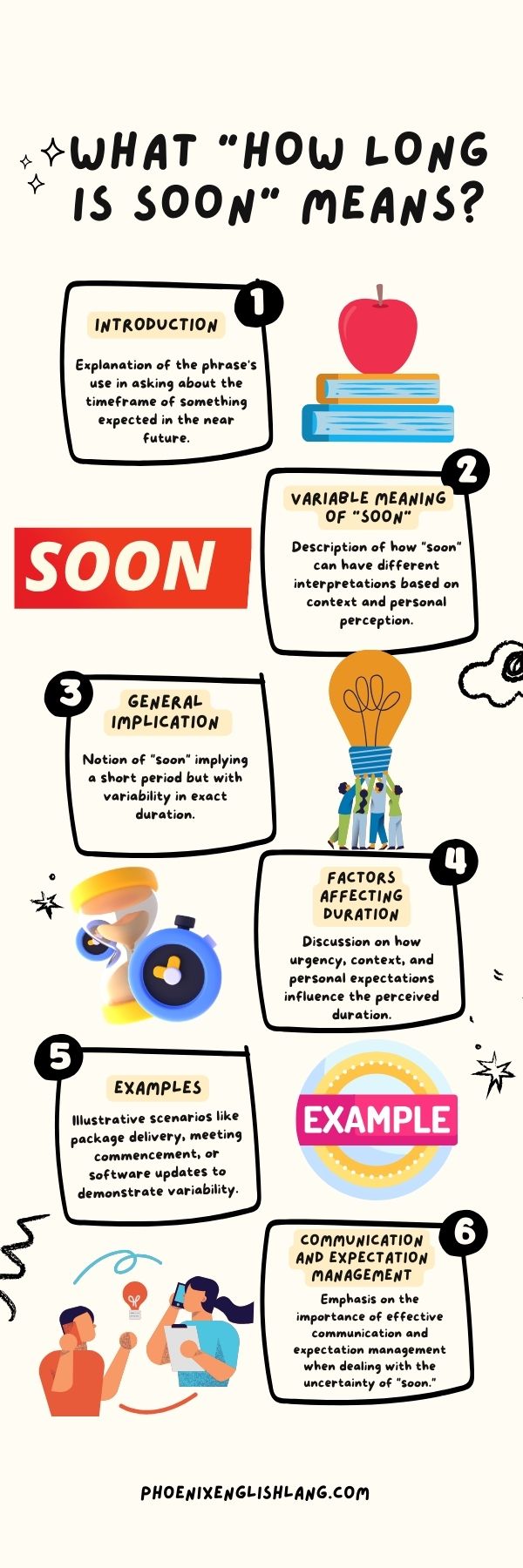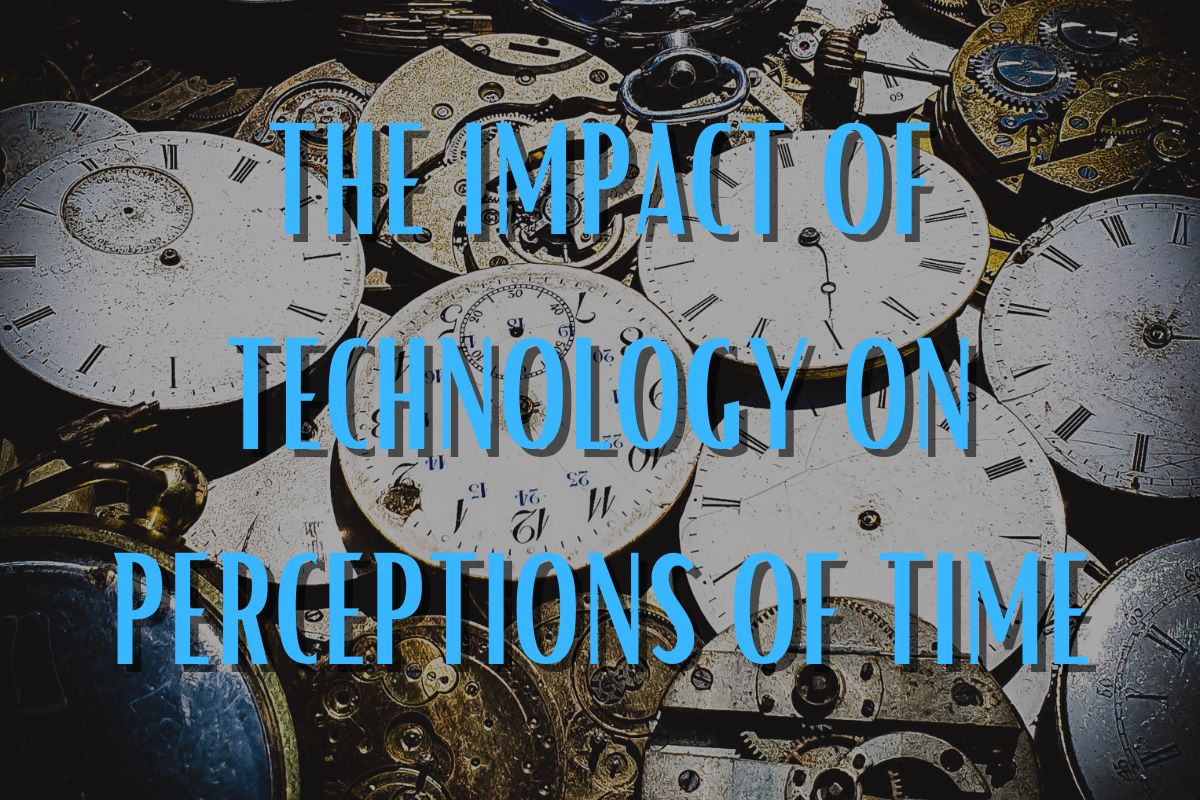The phrase “how soon is soon” is a popular saying that people use to ask about the timeframe or length of time for something that is expected to occur soon.
It is a question that arises when individuals want to clarify and comprehend the timing of specific events or results.
However, the term “soon” is subjective by nature and can differ significantly based on the situation and personal perception.
The idea of “soon” is frequently employed to express a feeling of excitement and anticipation.
It indicates that something is on its way, although the precise timeframe can be subjective.
Although it typically implies a brief period, the actual length of time can differ greatly depending on the circumstances and the individual’s expectations.
It is essential to grasp the subjective nature of the term “soon” in order to communicate and manage expectations effectively.
People may have varying understandings of what “soon” entails, which can result in misunderstandings or misaligned expectations.
Hence, it is crucial to take into account different factors that influence how time is perceived and the duration of “soon.”
In the upcoming sections, we will delve into the subjectivity of “soon” in greater depth.
We will analyze the various factors that can impact its duration, present real-life instances of its usage in diverse situations, and offer strategies for effectively managing expectations when employing this term.
By acquiring a deeper comprehension of the notion of “how long is soon,” we can navigate the uncertainty surrounding it and enhance our communication skills in our day-to-day interactions.
What “How Long Is Soon” means?

The phrase “How Long Is Soon” is used to ask about the timeframe or duration of something that is expected to happen in the near future.
However, the term “soon” can mean different things depending on the situation and how each person perceives it.
It generally suggests a short period of time, but the exact length can vary.
Factors like urgency, context, and personal expectations play a role in determining the duration.
For instance, it could mean receiving a package in a few business days, starting a meeting in 15 minutes, or getting a software update within a week.
When dealing with the uncertainty of “soon,” effective communication and managing expectations are essential.
You might also enjoy: Looking Forward To Seeing You: Grammar + Examples[2024]
Understanding the Subjectivity of “Soon”
To truly grasp the concept of “soon,” it’s important to acknowledge its subjective nature.
I can shed light on the various factors that contribute to this subjectivity.
Firstly, everyone perceives time differently. Each person has their own unique sense of urgency and patience, which affects how they understand “soon.”
What may feel like an eternity to one person could be seen as a brief moment to another.
Secondly, cultural and societal norms also shape our perception of time.
Different cultures have distinct attitudes towards punctuality and time management, leading to varying interpretations of “soon” based on cultural backgrounds and societal expectations.
Moreover, the context in which “soon” is used greatly influences its meaning.
In a business setting, for instance, “soon” may imply a shorter timeframe due to the need for efficiency and promptness.
Conversely, in a leisurely social context, “soon” might indicate a more relaxed and flexible timeframe.
Additionally, the level of anticipation or importance attached to an event or action can impact our perception of “soon.”
When eagerly awaiting something, time may seem to drag on, making “soon” feel further away.
Conversely, when an event holds little significance, “soon” may be perceived as a relatively short period.
In conclusion, understanding the subjectivity of “soon” requires acknowledging the individual, cultural, contextual, and emotional factors that shape our perception of time.
By recognizing these influences, we can engage in more effective conversations and manage expectations better when using this term.
Factors Influencing the Length of “Soon”

When we think about the concept of “soon” and how long it actually means, there are several factors that come into play and affect how we interpret it.
Understanding these factors can help us navigate the ambiguity of this word in different situations.
You might also enjoy:Has Ran or Has Run: My 2024 + Examples
1. Contextual Relevance
The importance and urgency of the event or task at hand play a significant role in determining the length of “soon.”
For example, if there is a deadline approaching, “soon” may imply a shorter timeframe compared to a less urgent task.
2. Individual Perception
Each person has their own perception of time, which is influenced by their personal experiences, cultural background, and even their personality traits.
As a result, what one person considers “soon” may differ from another person’s interpretation.
3. Time Sensitivity
The urgency or time sensitivity of the situation can impact how long “soon” actually means.
In emergency situations, “soon” may imply immediate action, whereas in non-urgent matters, it could refer to a longer timeframe.
4. Communication and Expectations
Clear and effective communication is crucial in managing expectations related to “soon.”
Providing specific timeframes or using alternative terms like “within the hour” or “by the end of the day” can help avoid misunderstandings.
5. External Factors
External factors such as workload, availability of resources, or unforeseen circumstances can influence the length of “soon.”
These factors may cause delays or expedite the completion of a task, which in turn alters our perception of time.
6. Cultural and Social Norms
Cultural and social norms also play a role in how we interpret “soon.”
Different cultures may have varying expectations when it comes to punctuality and timeliness, which can affect how individuals perceive the length of “soon.”
7. Technology and Instant Gratification
In today’s fast-paced digital era, technology has conditioned us to expect instant results.
This can influence our perception of “soon,” as we have become accustomed to immediate responses and quick turnarounds.
By considering these factors, we can better understand the subjective nature of the term “soon” and navigate its ambiguity in various contexts.
You might also enjoy: Would It Be Possible: Meaning, Usage, and Examples; My Personal Method In Teaching ;Would It Be;
Real-life Examples of “Soon” in Different Contexts

In different situations, the word “soon” is commonly used to indicate that something is about to happen or is coming up.
Let’s take a look at some real-life examples that show how “soon” is used and how it can be subjective.
1. Business and Project Deadlines
“The project deadline is approaching quickly, so it’s important to allocate resources efficiently and prioritize tasks accordingly.”
2. Product Releases and Updates
“The highly anticipated smartphone model will be hitting the market in the near future, creating excitement among tech enthusiasts.”
3. Event Planning and Invitations
“Save the date! The wedding ceremony will be happening before long, and we can’t wait to celebrate this special occasion with you.”
4. Weather Forecasts
“The storm is expected to pass in a little while, but it’s best to stay indoors until the weather conditions improve.”
5. Medical Appointments
“The doctor will see you shortly, as they are currently attending to another patient. We appreciate your patience.”
6. Online Order Deliveries
“Your package is on its way and will be arriving shortly. Please make sure someone is available to receive it.”
It’s important to remember that everyone’s perception of “soon” can be different depending on their expectations and the specific situation.
If you need more clarity or specific timeframes, it’s always a good idea to ask for clarification to avoid any misunderstandings.
You might also enjoy: In Vs Within in English Grammar: 10 Main Differences
The Impact of Technology on Perceptions of Time

In today’s fast-paced digital age, the impact of technology on our perception of time cannot be ignored.
The integration of technology into our daily lives has brought about numerous changes, both positive and negative, in how we perceive and experience time.
One significant effect of technology on our perception of time is the speed at which we communicate and exchange information.
With the rise of instant messaging, social media platforms, and email, we have grown accustomed to receiving immediate responses and updates.
This constant connectivity has created an expectation of instant gratification, resulting in a decreased tolerance for waiting and a heightened sense of urgency.
Moreover, technology has made our lives more convenient and efficient, which has compressed our sense of time.
Tasks that used to require a significant amount of time and effort can now be completed with just a few clicks or taps.
For example, online shopping allows us to make purchases within seconds, eliminating the need for physical travel and browsing through stores.
This acceleration of processes has led to a perception that time is passing more quickly, as we accomplish more in shorter periods.
Additionally, the prevalence of smartphones and other devices has resulted in a constant bombardment of notifications, alerts, and updates.
This continuous stream of information can create a sense of time fragmentation, as our attention is frequently diverted from one task to another.
This fragmentation can distort our perception of time, as we struggle to maintain focus and engage in deep, uninterrupted work.
However, it is important to acknowledge that technology has also provided us with tools and resources to effectively manage our time.
Productivity apps, time-tracking software, and digital calendars enable us to schedule and prioritize tasks, enhancing our ability to manage our time efficiently.
These tools can help counterbalance the negative effects of technology on our perception of time by providing structure and organization.
To sum up, there is no denying the influence of technology on how we perceive time.
It has undoubtedly sped up communication and made us feel like time is passing by faster.
However, it has also brought about some difficulties like being constantly connected and feeling like our time is fragmented.
By embracing the advantages of technology while being aware of its downsides, we can aim for a harmonious balance and maximize our time in this digital era.
Managing Expectations: Communicating Timeframes Effectively
Managing expectations plays a vital role in effective communication.
When it comes to timeframes, it is crucial to convey information accurately and transparently.
In my classes, I emphasize the importance of setting realistic expectations and providing clear timelines to avoid misunderstandings and build trust.
A key strategy for managing expectations is to be upfront about the time required for a task or project.
By giving a realistic estimate, you can help stakeholders understand the scope and potential challenges involved.
It is important to consider any possible delays or unforeseen circumstances that may arise during the process.
Another technique I teach is breaking down larger tasks into smaller milestones or deliverables.
This approach allows for better tracking and communication of progress.
By regularly updating stakeholders on the completion of these milestones, you can keep them informed and effectively manage their expectations.
Moreover, it is crucial to promptly communicate any changes or delays.
If there are unexpected obstacles or delays, it is important to inform stakeholders as soon as possible.
This demonstrates transparency and helps manage expectations by allowing stakeholders to adjust their own plans accordingly.
In my classes, I also emphasize the significance of active listening and understanding the needs and priorities of stakeholders.
By actively engaging in conversations and clarifying expectations, you can ensure that everyone is on the same page regarding timeframes and deliverables.
Overall, managing expectations when it comes to timeframes requires clear and transparent communication.
By setting realistic expectations, breaking down tasks, promptly communicating changes, and actively listening to stakeholders, you can effectively manage expectations and foster successful collaborations.
The Psychological Aspect of Waiting for “Soon”

The topic of waiting for something that is promised to happen “soon” is something I frequently discuss in my classes.
Understanding how this waiting period affects individuals psychologically is crucial for effective communication and managing expectations.
One concept I teach is called the “soon effect,” which is a psychological phenomenon.
When people are told that something will happen soon, their perception of time can become distorted.
The waiting period may feel longer than it actually is. This phenomenon is influenced by factors such as individual expectations, the importance of the event, and the level of uncertainty surrounding the timeframe.
In my classes, I stress the importance of being mindful of the “soon effect” when communicating timeframes.
It’s essential to provide clear and specific information to minimize ambiguity and reduce the psychological impact of waiting.
Instead of using vague terms like “soon,” it’s advisable to provide a more concrete timeframe or specific milestones.
This helps individuals better understand and manage their expectations.
I also emphasize the significance of proactive communication during the waiting period.
Keeping stakeholders informed about any progress or updates can help alleviate anxiety and uncertainty.
Even if there is no significant change in the timeframe, regular updates demonstrate transparency and show that their needs are being considered.
Furthermore, I highlight the importance of empathy and understanding when dealing with individuals who are waiting for something “soon.”
Acknowledging their feelings and providing reassurance can go a long way in managing their expectations and reducing any potential frustration or disappointment.
To sum up, the psychological aspect of anticipating something “soon” is a multifaceted phenomenon that demands thoughtful attention in communication.
By grasping the concept of the “soon effect,” offering precise and detailed information, staying proactive in communication, and showing empathy, we can successfully handle expectations and provide support to individuals while they wait.
You might also enjoy: Top 50 Professional Synonyms for ;I Would Love;
Can you provide an example of a situation where “soon” could mean a longer period of time?
Certainly! In a business context, if a manager tells their team that they will be launching a new product “soon,” it could mean several months, as the process of developing and launching a product can take a significant amount of time.
In this case, “soon” is used in a relative sense, indicating that the product will be launched in the near future within the context of the product development timeline.
How does the perception of time vary in a business context compared to a personal context?
In a business context, time is often perceived as a valuable and finite resource. Deadlines, project timelines, and financial goals can drive a sense of urgency, leading to a more structured and time-sensitive approach to decision-making and planning.
In a personal context, time may be perceived more subjectively. People may have more flexibility in how they allocate their time, and their priorities and commitments are often more diverse and individualized. Personal relationships, leisure activities, and self-care can influence how time is perceived and managed.
Overall, the perception of time in a business context tends to be more structured, goal-oriented, and driven by external factors such as market demands and competition, whereas in a personal context, it can be more influenced by individual preferences, emotions, and relationships.
How can understanding the differences in the perception of time between business and personal contexts help individuals better manage their time in both areas of their lives?
Understanding the differences in the perception of time between business and personal contexts can help individuals better manage their time in both areas of their lives in several ways:
- Prioritization: Recognizing the differing time demands of business and personal life allows individuals to prioritize tasks and activities more effectively. They can allocate time based on the specific requirements and expectations of each context.
- Time management techniques: Individuals can apply different time management techniques tailored to each context. For example, in a business context, they might use techniques such as project management tools and scheduling software, whereas in their personal life, they might prioritize using methods that align with their personal values and goals.
- Setting boundaries: Understanding the time demands of each context can help individuals set boundaries to prevent work from encroaching on personal time and vice versa. This could involve setting specific work hours and dedicated personal time to maintain a healthy work-life balance.
- Communication: Understanding the differences in time perception can also help individuals communicate their availability and time commitments more effectively, both at work and in their personal lives.
- Flexibility: Recognizing the differing time demands allows individuals to adopt a more flexible approach to time management, allowing them to adapt their strategies based on the specific needs of each context.
By understanding and acknowledging the differences in time perception between business and personal contexts, individuals can develop more nuanced and effective time management strategies to optimize their productivity and well-being in both areas of their lives.
How do you typically interpret the term soon when someone uses it in conversation with you?
When someone uses the term “soon” in conversation, I interpret it as a relative time frame that suggests an action or event will happen in the near future.
However, the exact meaning can vary depending on the context and the individual’s communication style. It could imply anything from a short timeframe to a more extended but unspecified period. If you need more clarity, it’s often helpful to ask for a specific timeline.
Have you ever experienced any misunderstanding or miscommunication due to differing interpretations of the word soon ?
No, I don’t experience misunderstandings or miscommunication because I don’t have personal experiences or emotions.
However, I understand that the term “soon” can be subjective and lead to misunderstandings among individuals due to its relative nature.
People might have different expectations about what “soon” means, and it can vary based on context and personal perspectives.
Conclusion
To sum up, dealing with the uncertainty surrounding the word “soon” in our daily lives can be quite challenging.
However, by using effective communication techniques and managing expectations, we can minimize misunderstandings and promote better comprehension.
It’s crucial to understand that everyone may interpret “soon” differently, leading to varying expectations and potential frustrations.
To navigate this ambiguity, clear and open communication is essential.
When using the term “soon,” it’s important to provide additional context or specific timeframes to avoid confusion.
Moreover, actively listening to others and understanding their perspectives can assist in managing expectations.
By engaging in conversations and clarifying what “soon” means to each person, we can align our understanding and prevent unnecessary disappointments.
Additionally, setting realistic expectations and being transparent about any possible delays or obstacles can contribute to smoother interactions.
By promptly communicating changes and keeping all parties informed, we can maintain trust and understanding.
In our everyday lives, successfully navigating the ambiguity of “soon” requires a proactive approach to communication.
By being mindful of potential misunderstandings and employing effective strategies, we can cultivate better relationships and ensure smoother interactions in various situations.
Ultimately, by acknowledging the inherent ambiguity of the word “soon” and taking proactive measures to clarify expectations, we can navigate everyday life with greater clarity and understanding.

Hi, welcome to my blog! My name is Omid and I am thrilled to have you here! I am an English language teacher with 12 years of experience and hold multiple international certifications (TESOL, IELTS, TOEFL, PTE, CELTA). Additionally, I hold a PhD in Applied Linguistics with a specialization in Teaching English as a Second Language (TESL), which fuels my passion for teaching English and assisting others in mastering the language. To me, nothing is more rewarding than helping individuals enhance their English language abilities through various methods. So, let’s embark on this journey of learning English together.





